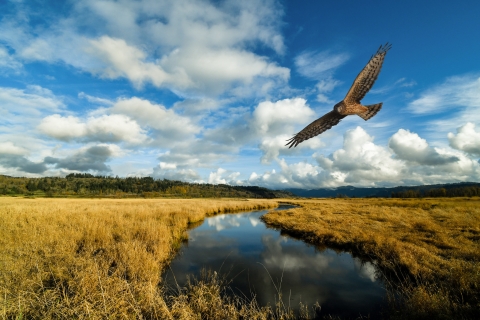Since its designation as a National Wildlife Refuge, Steigerwald Lake has evolved into a beloved destination for travelers and neighbors from both sides of the Columbia River. Stunning views, meandering trails, and an amazing mix of birds invite a sense of wonder. Now, another evolutionary leap is underway; to reconnect the Gibbons Creek watershed and Steigerwald Lake back to the Columbia River.
Through the Steigerwald Reconnection Project, the Refuge will greatly enhance habitat for aquatic animals such as Pacific lamprey and salmonids while also addressing critical community needs.
Project Need:
Prior to the project, the existing levee system stopped Gibbons Creek from being able to ;naturally drain into the Columbia River and as a result, it often flooded public and private property and infrastructure adjacent to the refuge. Additionally, the existing levee obstructed fish passage fish passage
Fish passage is the ability of fish or other aquatic species to move freely throughout their life to find food, reproduce, and complete their natural migration cycles. Millions of barriers to fish passage across the country are fragmenting habitat and leading to species declines. The U.S. Fish and Wildlife Service's National Fish Passage Program is working to reconnect watersheds to benefit both wildlife and people.
Learn more about fish passage , disconnecting them from floodplain habitat; critical for salmon rearing (breading).
Goals and Objectives:
The objective of the project was to reconnect the Gibbons Creek watershed and Steigerwald Lake back to the Columbia River.
Refuge habitats will function more naturally by restoring the natural flow and path of Gibbons Creek and removing its diversion structure structure
Something temporarily or permanently constructed, built, or placed; and constructed of natural or manufactured parts including, but not limited to, a building, shed, cabin, porch, bridge, walkway, stair steps, sign, landing, platform, dock, rack, fence, telecommunication device, antennae, fish cleaning table, satellite dish/mount, or well head.
Learn more about structure and fish ladder. Public and private lands will be protected from the natural ebb and flow of the floodplain by removing 2.2 miles of existing levee and creating two new setback levees. Neighbors and travelers will also see improved flood protection as SR-14 is raised to the 500-year flood level (~five feet above the peak of the 1996 flood) and the capacity of the Gibbons Creek bridge is increased.
Project Benefits:
Habitat
Restore 965 acres of historic Columbia River floodplain habitat
Provide year-round access for salmon and lamprey to the floodplain and the entire Gibbons Creek watershed.
Wildlife habitat will increase from restored wetlands and over 200 acres revegetated with native trees and shrubs.
Habitat quality will be enhanced by adding large wood debris and other natural features.
Removal of the fish ladder and levee will provide unobstructed passage for salmon and lamprey as well as much needed place for juvenile salmon to rest on their challenging migration to the ocean.
Flood Control
Reduce flood risk to State Route 14 and residences, some of which flooded in 1996.
Remove approximately 125 acres of Port and City infrastructure from the FEMA flood zone, including a wastewater treatment plant that services 15,000 residents.
Reduce Port pumping and maintenance costs (up to $60,000 annually in electric costs alone).
Eliminate the failing diversion structure and elevated canal, saving USFWS $4 million to replace.
Maintain flood protection seven feet above the Columbia River’s 500-year flood elevation.
Recreation & Education
Build a new, larger parking lot at the Refuge main entrance
Expand trail system, with over a mile of new trail, and new overlooks and footbridges
Engage the public and local students through field trips and public volunteer plantings
Increase tourism and recreation that will benefit restaurants, shops, and other local businesses.
To learn more about the project visit: Refuge 2020

